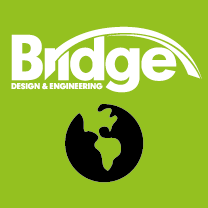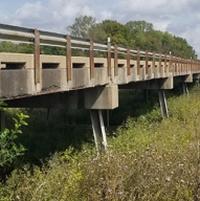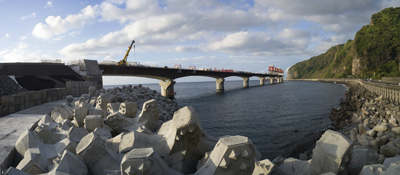
Among the equipment in use on the 5.4km-long offshore section of the viaduct is a mega-barge capable of placing pier bases on the seabed to an accuracy of 50mm without the use of mooring winches. The Nouvelle Route du Littoral will connect the capital city of Saint Denis with Réunion Island’s commercial harbour, situated around 20km to the south in the city of La Possession.
The offshore section of the new 12.5km-long connection will rise to 30m above sea level and run parallel to the coastline, thus avoiding the rock falls, tropical storms and sea spray that regularly close the existing coastal highway.
As well as the offshore viaduct the NRL project includes a now-completed 240m-long viaduct at the village of La Grande Chaloupe to the south as well as a series of embankments with a total length of 6.7km and an interchange at La Possession.
Réunion Island is 900km east of Madagascar in the midst of the Indian Ocean, and the new connection is being built by a consortium of Vinci Construction subsidiaries Vinci Construction Grands Projets and Dodin Campenon Bernard together with Bouygues Travaux Publics and Demathieu Bard; the client is La Réunion Région.
Initially the viaduct will carry two lanes of traffic in each direction, a single lane for public transport, and a dedicated path for pedestrians and cyclists. At a later stage the lane reserved for public transport will be replaced by a light-rail line, with a second line planned for the future as well as the installation of an additional pedestrian and cycle path.
The 5.4km-long structure has been divided into seven 770m-long successive decks supported by 50 structures; two cast in situ abutments and 48 piers, of which six are pier-abutments, seven are fixed piers and 35 standard piers. The six pier-abutments support the deck at the expansion joints with two pot bearings on each side of the piers. The standard span is 120m long plus two 85m-long side spans. The deck, a prestressed box girder type, is 29.8m wide and has a depth that varies from 3.8m to 7.3m.
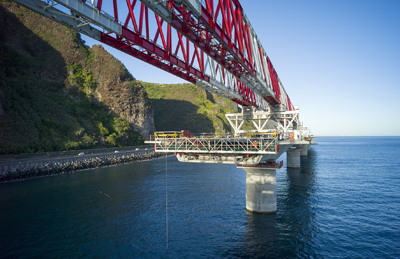
According to Francis Guinchard, director of the viaduct construction joint venture, the project is approaching roughly 30% of progress, with all main construction methods and equipment developed; the challenge is now to continue for two further years. There have been some delays, which Guinchard describes as now being ‘within reasonable control’, adding: “I would say we are between six and 12 months in delay, which for a project of this size is nothing.”
The latest stage, completed in May, involved the strengthening of the soil at eleven locations on the seabed that had been identified as being potentially too weak to reliably support the piers. Using the so-called vibroflotation method, a specialist probe systematically vibrated the soil in the affected areas and backfilled the gaps with granular material. “Everything has been measured, and the expected level of improvement of soil characteristics via this method has been met, so now vibroflotation works are behind us,” says Guinchard.
The construction activities are split into two main columns of work, landside and marine. Landside activities include casting the deck and pier units as well as the assembly of the deck from the south, which all take place on a five-day-week basis on a daily two-shift system running 6am to 10pm.
As for the marine works, which primarily involve the transport and installation of large precast elements at sea using a jack-up barge, these are taking place around the clock whenever conditions are suitable. While the tidal range of just 500mm would suggest virtually uninterrupted activity, on average construction cycles at sea are limited to between 50% and 70% of the available time due to the significant sea swell as well as the fact that the location is exposed to tropical hurricanes.
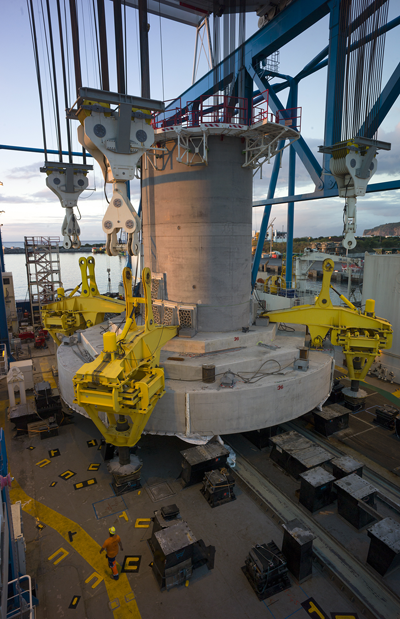
One of the current challenges being faced involves the preparation works for the installation of a scour-protection system for the piers, which Guinchard describes as ambitious and innovative. The consortium plans to place 1.5t to 2t concrete blocks inside geotextile mattresses, two of which are wrapped around each pier. For a 20m-diameter pier, this equates to 1,056 blocks of 1m2 and 400mm deep. They will be cast in situ to ensure proper bonding between the concrete block and the geotextile as well as good mechanical connection between the textile matting of both mattresses.
This is something that Guinchard does not think has been done before on this scale. “Now we are mobilising the necessary equipment for the installation under sea, and that for us is our next big challenge. We are at the start of it and hopefully all our plans are sound,” he says. One of the alternative options considered at an earlier stage was to use anti-scour mats made of recycled tyres, but this was discarded after they failed to meet the contractual design specifications in tests.
The concrete geo-matting will be transported to each pier on an 80m-long, 26m-wide, 6m-deep pontoon. The pontoon will also be fitted with steel structures that are currently being designed and fabricated to handle the geo-matting and place it below sea. Whilst this is happening, the erection of the remaining piers will continue.
At the time of writing 11 piers were in place, with the next pier marking the significant 25% milestone in progress. The pier sections are being installed by the Zourite barge, a 107m-long, 44m-wide heavy-lift jack-up constructed by the Crist shipyard in Poland which carries a specially-designed overhead travel crane with a lifting capacity of 4,800t. Designed by Enerpac, the crane uses a reeved winch system based on eight grooved drum winches. Longitudinal travelling of the gantry uses a trolley arrangement comprising two trolleys per lifting beam, and each trolley is propelled by hydraulic drive motors and planetary gearboxes. The wheels run on two parallel rails bolted onto the barge’s runway beams. Side shifting of the gantry hoists in a continuous movement is achieved using long stroke cylinders.
The learning curve for the operation of the barge and crane has been relatively long, says Guinchard. The barge arrived in May last year, and there followed a period of three months while additional equipment that had not arrived in time at the shipyard was fitted. The ‘real’ training took place when work started on the first pier base in August 2016, and continued until November.
Some issues have been encountered with the jacking system of the barge, says Guinchard, which rather than the more common four legs actually has eight legs for stabilisation purposes. “Synchronising jacking on eight legs doesn’t necessarily work on site as well as in the office,” he reveals. The complex control system of the jacking system, which includes a whole raft of sensors to help control movement in all directions, required some adjustment until the optimum functioning level was finalised.
Nevertheless, from January this year onwards it has been full speed ahead with a regular construction cycle. For each pier, the Zourite first places a 20m or 23m-diameter, 2.4m-thick circular pier base on the seabed as well as a 10m-long lower pier section on top, the latter extending some 3m above the water. Then the Zourite returns to the precast yard to be loaded with a collar, made up of the upper part of the pier and portal cap beam, as well as a deck section. These sections are placed and stitched with concrete and reinforcement; within two or three days of the installation the structure is capable of resisting whatever forces the sea can muster.
A significant concern for the project was the placement of the pier base in the exact location, however in practice this operation is turning out to be relatively painless. “The first point is to place the jack-up barge at the right location, which is being done thanks to a dynamic positioning system. This system is in fact extremely efficient because we are placing the barge at the right location with a precision of 20 to 30cm,” he reveals. The computer-controlled dynamic positioning system was supplied by Sirehna and installed by D-Ice Engineering. It automatically maintains the Zourite’s position using the barge’s own propellers and thrusters. Position reference sensors, combined with wind sensors, motion sensors and gyrocompasses, provide information to the computer about the vessel’s position and the magnitude and direction of environmental forces affecting its position.
Originally, to assist with the positioning, the plan was to complement the dynamic positioning system with four mooring winches: “But we are not using them at all,” says Guinchard. “The DP on its own is allowing excellent positioning for the barge while it is floating, until the legs are down. To be honest we were not expecting such a reliable positioning to be achieved this way,” he notes.
As an accuracy greater than 300mm was required for the pier’s final positioning, with design plans accepting an offset of only 100mm, 50mm was the offset target figure for each pier base. To achieve this, Guinchard explains that each pier base is fitted with four hydraulic devices akin to extendable mobile crane legs at four opposite ends. The devices form the synchronised pier positioning system that is used to level the base on the sea bed as well as move it in the x and y directions relative to the fixed points, until the exact position is achieved.
As each pier base is placed directly on sand, a solution had to be found to fill the gap between the underside of the pier base and the sea bed. For this, an automated foundation grout bag system designed and supplied by marine construction engineering firm Proserve is being used. Vertical and horizontal filler pipes are cast into the pier base, after which six empty grout bags are installed at the fabrication yard on the underside of each pier base and zipped together.
Once a pier base is in place, injection hoses are fitted to the pipes in the pier base walls, and they are used to fill the grout bags with a mixture of grout and water from the onboard batching plant. Two vent sleeves with automated grout sensors prevent the bags overfilling or exerting too much pressure on the pier base. At Réunion, the process is also being overseen by a diver: “We don’t want to rush it because you have to push the grout very gently. The intention is to open the bag without tearing it. Once grout is seen coming out of the special vents in the bags it is time to stop filling and move on to the next bag,” says Guinchard, who adds that this method of load bearing for precast elements on the ground is working well. The process takes around 20 hours and involves around 200m3 of grout per base.
Foundation grout bag system technology has been around for around 50 years, explains Proserve design and project engineer Matthew King, newly returned from Réunion Island. A grout bag perimeter seal was used in the early 1990s to found the caissons on to dredged rockhead for the Second Severn Crossing between England and Wales. More recently, it is providing the foundations for 20,000t concrete caissons in the Mose barrage project currently under construction in Venice, which will protect the city from high tides.
Work on the deck of the NRL is also under way at the viaduct’s starting point, a 600m-long embankment near La Grande Chaloupe viaduct, and around 500m of decking has been assembled so far. The deck is being constructed with a 278m-long launching beam supported by two lattice towers and a front leg, using the balanced-cantilever method. The launching beam transports the 4.1m-long segments to form a half span on either side of the pier, which on one side is then stitched to the previously installed half span; the other side remains as a half-span cantilever until the front leg of the launching beam is positioned on the next pier, ready for the process to start again.
The 300t deck sections are transported during the night from the casting yard and fed to the rear of the launching beam along the previously formed deck. The 18 axles of each of the tyre-mounted transporters, made by Goldhofer, spread the load on the road to a similar level as that of an articulated truck. When the beam launcher is not being repositioned, work on the deck is progressing at the rate of around 32m per day.
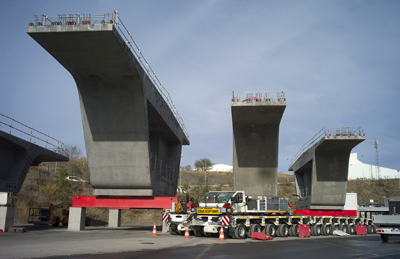
Precasting of the 1,386 segments of the deck is slightly more advanced than that of the pier sections, with around 460 segments cast by the end of May; around 40% of the total. The precasting of the pier elements and the deck segments is taking place at two sites in the town of Le Porte, which serves as the main harbour for the island.
An initial decision to construct as much as possible of the NRL on land has turned out to be the correct one, reflects Guinchard: “We are still convinced that doing as much as possible on land is a good option, not only because of the sea conditions but because this is an island with practically no shelter. If we had to do it again we would probably use the same general approach.”
The project has been assisted by the port authority’s decision to grant the consortium permission to shelter its large marine vessels in the port. Standard practice requires that larger vessels leave a port prior to the arrival of a hurricane and Le Port, next to La Possession, has little extra shelter in its harbour.
The next new construction challenges are scheduled to begin some time between October this year and January 2018 and will continue until 2019. Waterproofing works and asphalt will come first, along with construction of parapets and side gullies, and secondly the placement of anti-scouring protection around the piers. The NRL is split into a number of contracts and, says Guinchard, there is talk of opening the viaduct towards the end of 2020 or early 2021. If all goes to plan, the marine viaduct section, worth around US$800 million and arguably the most challenging, is likely to be completed in early 2020.
This report was first published in 2017 (Bd&e issue 88); an update on this project will be published in Bd&e issue 95.

